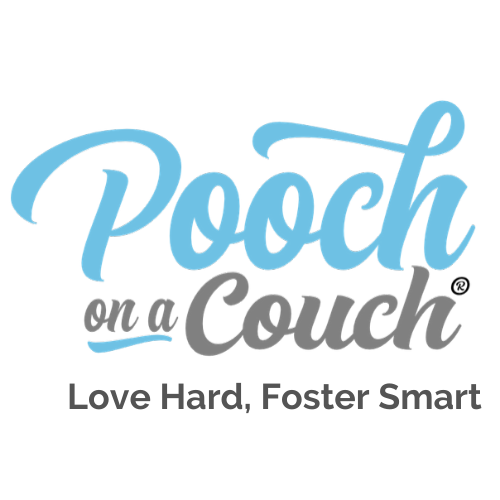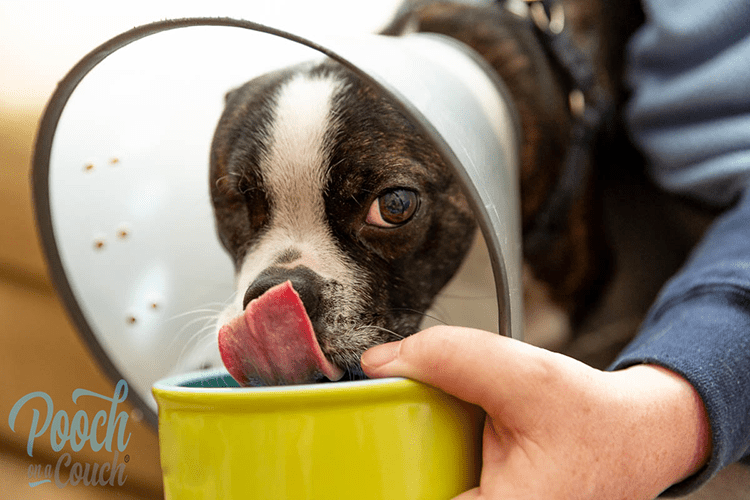I love how we as pet owners enjoy poo-pooing the plastic, vet-issue Elizabethan collar, abbreviated as the e-collar. (not to be confused with the abbreviation of the electronic or “shock” collar.)
After all, we have nicknamed it “The cone of shame”.
While I know there are some pets that absolutely will not tolerate the expansive, noisy, cumbersome, unfamiliar plastic bowl around their heads, most dogs, when given assistance and proper management of their environment, will quickly adjust to wearing this very important and protective tool.
Also, if you are a foster of a rescued dog, you may be required to keep the Elizabethan collar on your foster dog for the duration of the dog’s recovery.
I’m here to help you help your dog adjust to the e-collar.
Personally, I’ve tried many of the “alternative” products available on the market, and I always return to the plastic “vet-issue” Elizabethan collar.
Disclaimer: This post contains affiliate links. As an affiliate, I may earn a small commission on qualifying purchases, at no additional cost to you.
Here are 9 ways I help my dogs and all of my foster dogs adjust to wearing the Elizabethan collar.
1. Check The Emotions At The Door
I’m tender-hearted and I don’t like for my dogs to be unhappy. I know you are, too.
But – if we are to help a dog adjust to the e-collar, we are going to have to have a little bit of tough love sprinkled with kindness. We need to be tough when we see their pitiful “please take this off of me” sad eyes and normalize the situation as quickly as possible.
We need to be kind and modify everything we can so that their adjustment is a smooth, stress-free experience.
Tough love for us, and tough love and kindness for the dog.
2. Clear A Path
Take an assessment of all rooms your dog navigates. Ask yourself:
- How wide is the path between furnishings?
- Can your dog easily move between the sofa and the coffee table?
- What will your dog most likely bump into when moving toward the door or to the food bowl?
- What furnishings or belongings can you move back or remove from the room altogether?
- Is this room an absolute necessity for my dog during its recovery? If not, restrict access.
Yes, rearranging your furnishing may be a hassle. But your dog running into and possibly knocking the floor lamp over or getting their cone caught on the corner of the coffee table is only going to startle them, frighten them, or frustrate them.
The EASIER they can navigate, the more readily they will LEARN to navigate.
3. Don’t Leave Them Alone
Clear your social calendar. For the first several hours, your dog is going to need your help.
Remember, the cone feels funny and it is wider than their head. Their spacial awareness hasn’t yet taken into account just how large the cone is. Have you ever used crutches to navigate? It takes a little bit of practice, doesn’t it? Your dog needs practice, too.
You will need to help them navigate, figure out how to drink from the water bowl, and adjust their head position when moving about.
You are going to have to prevent them from falling on the stairs. You are going to have to intervene if the dog acts like they are having a temporary “come apart”. You are going to have to help them feel and stay safe. A dog that feels safe will more readily learn new and adaptive skills.
4. Adapt The Food and Water Bowls
One of my first goals with my dogs wearing an Elizabethan collar is to help them feel comfortable using their food and water bowls.
Most of the time, after a day or so and with me helping them practice, my dogs can use their bowls without any assistance or adaptations from me.
At first, I may hold the bowl and help them learn how to “aim” their head-with-new appendage. I put a few pieces of their food in the bowl and let them practice. After they get the hang of this, I slowly lower the bowl further and further toward the floor.
I usually elevate the water bowl for the first day or so. I don’t use anything fancy; I usually invert another bowl or pot and secure their water bowl with temporary adhesive. A hot glue gun or sticky tack works, but I’ve used those flat rubber jar openers between the bowls – it keeps things from sliding around.
Alternately, I might choose a taller, narrower vessel as a temporary water bowl.
It isn’t a bad thing to invest in an elevated bowl, especially if you have large breed dogs. Be sure the stand is small enough in circumference for a dog to get the entire cone around it with ease. I did a quick search on Amazon and honestly didn’t find an impressive product that didn’t cost a fortune. If you know of one, shoot me a comment. I’d love to see it!
5. Help Your Dog Navigate Doors and Stairs.
My foster dog, Carter, sometimes likes to dart through doors. If your dog likes to shoot through the doorway before you get the door all the way open, they are possibly going to jar themselves as the cone hits the door jamb.
Those uncomfortable and scary experiences don’t help a dog adjust to the cone.
If your dog is under vet-instructed exercise restriction, you already have them on a leash, I‘m sure of it.
Pick them up, connect them to a short leash, and completely open the door before allowing them to egress.
Stairs are really hard and dangerous for a dog wearing a cone, especially for little dogs wearing a larger cone. I don’t give them any opportunity to fall; I either pick them up and carry them up/down, or I get low and help guide them up. Sometimes, – and I do this for the larger dogs – all I have to do is grab the top rim of the cone and pitch it back so that the bottom of the cone rests under their chin. This way, they can slowly walk up steps without getting the cone caught.
6. Use A Bigger Crate
I usually size up when my dogs have to be crate-confined during recovery. Not only does it give them a bit more room, a larger crate slightly accommodates the presence of the Elizabethan collar.
I also help my dogs go through the crate door while they are wearing the collar. I’ll push the edges of the cone toward the head and guide them through. I’ve seen a dog (mine!) teach herself to go through the crate opening all by herself wearing the cone. Your dogs maybe can, too.
Yes – the collar clanks on the crate bars. Yes, your dog doesn’t like it.
Guess what. Dogs decide that taking a nap is more pleasant than feeling the collar clank on the bars. And rest helps them heal faster.
If your vet approves, you can also use an exercise pen to give them more room to move about.
If your dog is really having a hard time being confined and wearing the cone, by all means, call your veterinarian. It’s nobody’s intention for your dog to have a panic attack because of the cone.
Do keep in mind that protesting wearing the cone and a panic attack are two totally separate behaviors. Your veterinarian can help you sort out the differences.
7. Be Aware Of The Change In Senses
The shape of the cone may intensify sound and smell, and distort the origin of those sounds and smells. In other words, your dog may seem confused about where sounds and smells are coming from.
Equally, even many opaque Elizabethan collars restrict peripheral vision.
Be sensitive to the type and intensity of noise in your home, the intensity of smells outdoors, and be sensitive as you approach your dog from behind.
Again, the less confusion and stress your dog experiences early on, the more quickly they adapt to wearing the Elizabethan collar.
8. Announce Your Approach
Expanding on the above, your dog isn’t going to be able to fully process the sound and smell of your approach. This is especially important if you have a fearful dog or a dog that startles easily. Be kind in announcing your approach. Let your dog know you are behind them or move in front of them before you touch them. I might tap the floor or give a very light touch to the flank. Never pick up our dog from behind without giving them a cue if they cannot see you. We want to avoid setting up any dog to bite out of fear.
9. Supervise them Indoors and Outdoors
This is probably a moot point as you’ve also been instructed to leash walk your dog outdoors after surgery anyway (ahem!) but there are occasions when Elizabethan collars are used for non-surgical reasons like a severe ear infection.
Your dog can become injured or caught when trying to move about the grounds. Close up the pet door and keep your dog indoors when you cannot be outside supervising them.
There is one report of a dog getting its head caught in a plastic food bag while wearing a cone outdoors, unsupervised. Because he couldn’t use his paws to help remove the bag, he suffocated.
A Word About Alternative Products to the Elizabethan Collar
There are pros and cons to various products on the market. I’ve used many of them; and at best, I swap out the e-collar for alternative products depending upon our activity. That said, I always use the plastic Elizabethan Collar for most of our activities.
If you want to know the truth – the plastic Elizabethan collars are not easy to put on. I usually put them on and keep them on. My dogs seem to get a little stressed when I have to put the collar back on after removing it for some reason.
I might use the Comfy Cone when my dog is sleeping in their crate. (Except when there is an eye issue involved.) I don’t use it 100% of the time because it is so visually restrictive.
I’ve used the inflatable donut collar – again, it’s not protective in all situations, and I don’t think I’ve ever used it unsupervised. I think it can get caught on things and can cause airway restrictions if used incorrectly.
The donut doesn’t work for dogs that have thick necks and small heads. It comes right off with the flick of the paw.
I don’t own one, but I might use the Bite Not collar when taking a walk outdoors for potty time, or when all is quiet in the evenings and everyone is piled up on the sofa and I can supervise. I would never use the Bite Not collar exclusively. It doesn’t protect 100%, and there are reports of significant skin irritation and skin breakdown because moisture gets trapped. Bite Not collars are not useful for every e-collar need, check with your veterinarian if you want to use this.
To me, the Bite Not collar looks more cumbersome, uncomfortable, and restrictive than the “awful” plastic Elizabethan collar. I haven’t actually USED one, so there’s that point.
I did purchase my own Elizabethan collar because I found one that was less opaque, and my dogs do prefer being able to have access to their peripheral vision. I use the Remedy + Recovery Elizabethan collar. I’ve been really pleased.
How About You?
Do you have any helpful tips you use to aid your dog in adjusting to wearing the Elizabethan collar? Drop a note in comments!
More Fostering Resources
The Cone of Shame – What’s Not To Love?
Saving An Emaciated Dog – What You Need To Know
Need To Quarantine Your Dog? Here’s How




